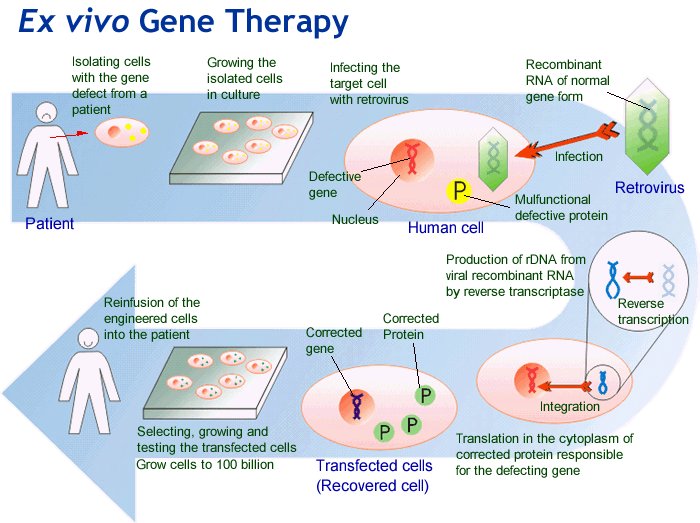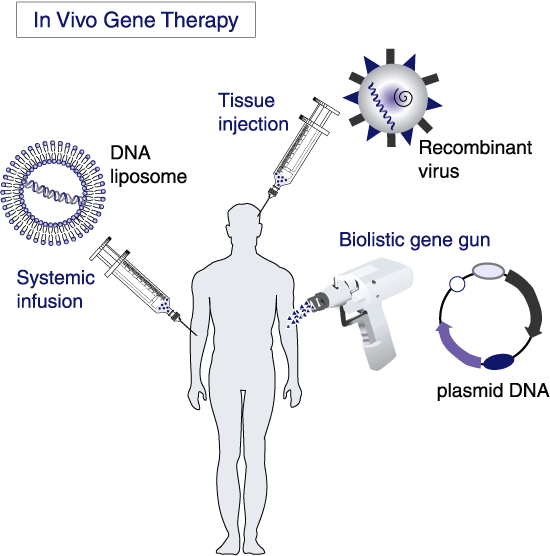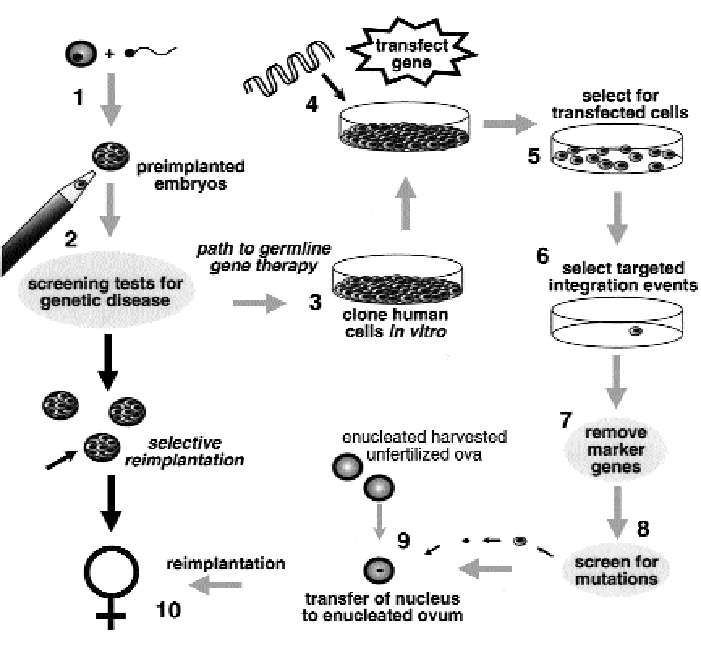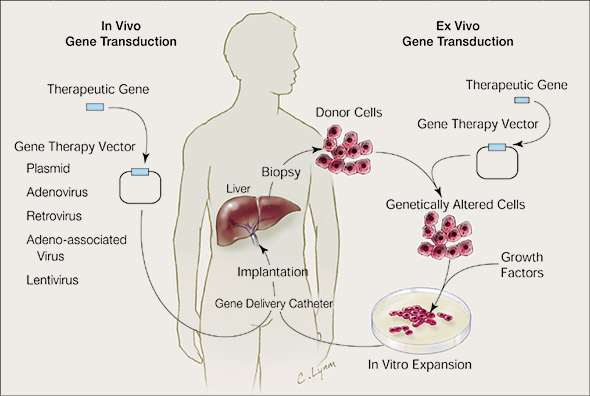THE two forms of gene therapy are:
|
 |
There are three categories of somatic cell gene therapy: 1. Ex vivo: The cells are removed from the body, incubated with a vector, and the gene-engineered cells are returned to the body This procedure is usually done with blood cells because they are the easiest to remove and return. |  |
2. In situ:
The vector is placed directly into the affected tissues. Examples are the infusion of adenoviral vectors into the trachea and bronchi of patients with cystic fibrosis, the injection of a tumour mass with a vector carrying the gene for a cytokine or a toxin, or the injection of a vector carrying a dystrophin gene directly into the muscle of a patient with muscular dystrophy.
3. In vivo: A vector could be injected directly into the bloodstream. There are no clinical examples of this third category as yet, but if gene therapy is to fulfil its promise as a therapeutic option, in vivo injectable vectors must be developed.[7] |  |
|  |
TREATMENT OF SOMATIC CELLS
Many of the ethical and religious reservations expressed about human gene therapy refer only to alterations that might affect the germ line to produce inherited changes, In the opinion of several ethicists and religious thinkers, treatment of somatic cells by genetic methods does not pose ethical problems different in kind from those presented by other types of experimental therapy such as new drugs or novel surgical techniques. The questions that need to be addressed in assessing the appropriateness of treating somatic cells include:
- · What is the likely impact on people’s regard for the sanctity of human life?
- · What are the risks of inadvertently affecting the germ line?
- · What are the precautions taken against deliberate misapplication?
- · What scientific data are available to suggest that the treatment might work to the patient’s benefit?
- · How serious is the disease? What are the realistic possibilities of benefit to the patient? What are the risks to the patient? What is the prognosis if there is no treatment?
- · What are the alternative methods of treatment? Is gene therapy likely to be more effective, less costly, safer, or otherwise more acceptable than available alternatives?
- · How safe is the procedure, based on the best available evidence? What are the data on short-term effects and long-term consequences?
- · Are patients or their surrogate decision-makers properly informed about the risks and benefits of the therapy?
- · Are the side effects of the treatment reversible or treatable in the patient and in the population?[17]
TREATMENT OF GERM CELLS
If ever applied to humans, germ line therapy could be done in several ways. Such therapy could be directed at sperm or ova, or cells that produce them, before the germ cells join to produce a fertilized egg. It could also be targeted at the early stages of development, currently practical only if performed within hours after fertilization, days before the embryo is implanted in the uterus.’ Human gene therapy affecting germ line cells raises several concerns in addition to those listed for somatic cell therapy. These have been noted by religious and civic commentators (Foundation on Economic Trends, 1984; National Council of Churches, 1984; President’s Commission, 1982), and include:
- · propagation of unpredictable effects (both positive and negative) into future generations,
- · diminishing genetic diversity among human populations, and
- · long-term effects of changing genetic characteristics in human populations.
The likelihood of inadvertently affecting the germ line is of greater concern for gene therapy than for most other treatments. The risk of genetically altering the germ line is not unique to gene therapy because several other medical practices —such as vaccination, cancer chemotherapy and radiation therapy—also carry this risk.[13][14]
COMPARISON OF SOMATIC AND GERMLINE GENE THERAPY

There are several technical and practical advantages to performing gene therapy on somatic cells as opposed to germ cells. The primary advantage of somatic cell therapy is that it can be performed on individuals at any stage of development, while germ line therapy as currently envisioned would have to be performed early in embryonic development. Experiments on somatic cells may be done on samples or parts of organs, rather than an entire organ, lowering the risks of failure because a failed experiment does not cause loss of the organ. Experiments involving somatic cells may also be repeated in the same individual if they fail, and the reliability of the gene transfer procedure does not have to be as high. Somatic cell gene therapy is also advantageous because it directly benefits the person to whom it is administered, rather than a person (who cannot consent to therapy) who develops from a treated embryo.
Despite these advantages of somatic therapy, there are several disadvantages. Somatic cell therapy may not be applicable to some disorders that affect multiple tissues, because cells of each organ would have to be altered. It may also not be effective for those tissues composed of cells that do not divide, such as brain and muscle (although symptoms of some diseases of nerve and muscle cells might be treated by gene therapy in other kinds of cells that influence brain and muscular function). Which diseases and which tissues might prove refractory to gene therapy of somatic cells will be determined only by further study of the specific genetic diseases in question.
There is at least one potential advantage to heritable correction of germ line cells. Once a defect were fixed, it would be less likely to plague the direct descendants of the person who developed from the treated embryo. This would not eliminate the risk, however, because new mutations causing the same disease could spontaneously arise.[14]